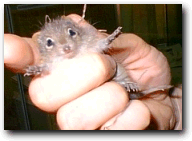
All living things are divided into seven categories using Latin terms that can
be understood worldwide. They progressively get smaller and more
numerous, and each contains less living things. Classification of living
things is used to help identify different animals and to group them together
with their relatives.
The first and largest category is the Kingdom. To date there are five
kingdoms: Animalia, which is made up of animals; Plantae, which is made
up of plants; Protista, which is made up of protists (single-celled creatures
invisible to the human eye); Fungi, which is made up of mushrooms, mold,
yeast, lichen, etc; and Monera, which is made up of the three types of
bacteria.
The next category is the Phylum. There are several phyla within each
kingdom. The phyla start to break the animals (or plants, fungi, etc) into
smaller and more recognizable groups. The best known phylum is
Chordata, which contains all animals with backbones (fish, birds,
mammals, reptiles, amphibians). There is also Arthropoda (insects, spiders,
crustaceans); Mollusca (snails, squid, clam); Annelida (segmented worms);
Echinodermata (starfish, sea urchins) and many, many more.
The next category that makes up the phyla is the Class. The class breaks up
animals into even more familiar groups. For example, the phylum Chordata
is broken down into several classes, including Aves (birds), Reptilia
(reptiles), Amphibia (amphibians), Mammalia (mammals) and
several others.
The next category is the Order. Each class is made up of one or more
orders. Mammalia can be broken down into Rodentia (mice, rats), Primates
(Old- and New-World monkeys), Chiroptera (bats), Insectivora (shrews,
moles), Carnivora (dogs, cats, weasels), Perissodactyla (horses, zebras),
Artiodactyla (cows), Proboscidea (elephants) and many more.
Orders can then be broken down into Families. The order Carnivora can be
broken down into Canidae (dogs), Felidae (cats), Ursidae (bears),
Hyaenidae (hyaenas, aardwolves), Mustelidae (weasels, wolverines), and
many more.
The next category is the Genus. The family Felidae, for example, can be
broken down into Acinonyx (cheetah), Panthera (lion, tiger), Neofelis
(clouded leopard) and Felis (domestic cats).
Finally, the genus is broken down into the Species. The genus Panthera can
be broken down to include Panthera leo (lion) and Panthera tigris (tiger).
Note that the genus is placed in front of the species.
To complicate things, each category can, in some cases, be broken down
into sub-categories. A sub-category is made when there are some animals
that are basically the same but live in different areas and behave differently
from each other or have some general differences in the anatomy. A prime
example is phylum Chordata, class Reptilia, order Squamata. The order
Squamata consists of both lizards and snakes because they are basically the
same. However, snakes have some physical differences, mainly the lack of
legs (although some lizards also lack legs). This warrants the creation of two
sub-orders: Serpentes (snakes) and Sauria (lizards). These are then broken
down into their own families.
Another example is phylum Chordata, class Mammalia, order Proboscidea,
family Elephantidae, genus Elephas and species maximus. Elephas maximus
(Asian elephant) is broken down into four sub-species depending on where
the sub-species lives and the physical description of it. One example is the
Ceylon elephant (Elephas maximus maximus). Note that the sub-species
follows the species and that they always receive lower-case letters.
It should be noted that most animals are given common names recognized
outside of the scientific community and that these names may be different
in each country. For example, in Canada a certain type of spider is known
as the daddy long-legs and is known as the harvester spider in the US.
Likewise a type of fly in the US is called the daddy long-legs and is known
as the crane fly in Canada. However, the Latin term remains the same.
It should lastly be noted that the Latin names of animals are always
changing. The Aleutian Canada goose has gone through ten name changes,
starting off as the non-sub-species Anser leucopreius and ending with the
sub-species Branta canadensis leucopareia. The name will most likely
change again in the future if it is decided that the Aleutian Canada goose is
an entirely separate species from the Canada goose or if there are no
subspecies at all and just the Canada goose.